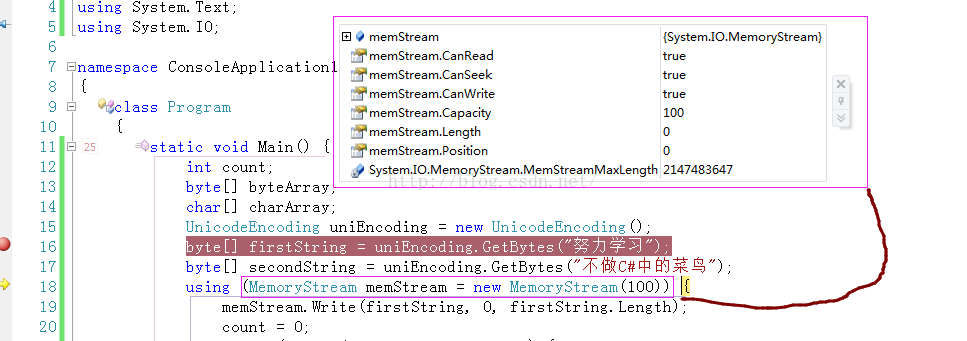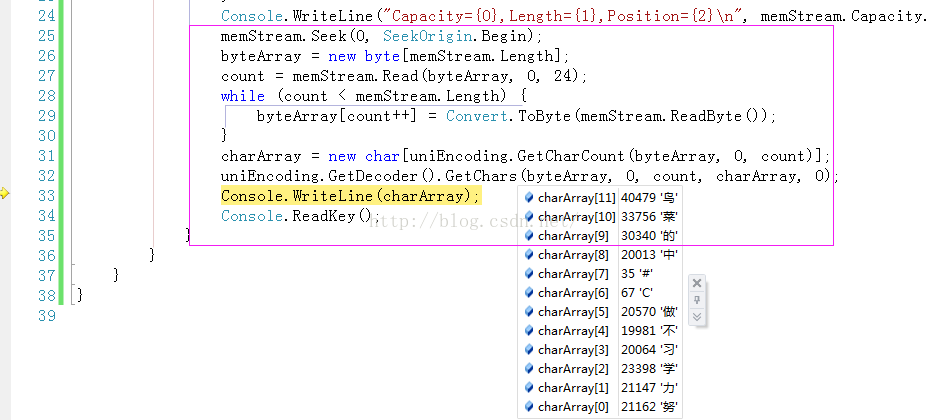C#的FileStream类提供了最原始的字节级上的文件读写功能,但我们习惯于对字符串操作,于是StreamWriter和 StreamReader类增强了FileStream,它让我们在字符串级别上操作文件,但有的时候我们还是需要在字节级上操作文件,却又不是一个字节 一个字节的操作,通常是2个、4个或8个字节这样操作,这便有了BinaryWriter和BinaryReader类,它们可以将一个字符或数字按指定 个数字节写入,也可以一次读取指定个数字节转为字符或数字。
1.BinaryWriter类
BinaryWriter类以二进制形式将基元类型写入流,并支持用特定的编码写入字符串。
常用的方法:
Close 关闭当前的BinaryWriter和基础流
Seek 设置当前流中的位置
Write 将值写入当前流
2.BinartReader类
BinartReader类用特定的编码将基元数据类型读作二进制值。
常用的方法:
Close 关闭当前阅读器及基础流
Read 从基础流中读取字符,并提升流的当前位置
ReadBytes 从当前流将count个字节读入字节数组,并使当前位置提升count个字节
ReadInt32 从当前流中读取4个字节有符号整数,并使流的当前位置提升4个字节
ReadString 从当前流读取一个字符串。字符串有长度前缀,一次7位地被编码为整数
下面看一个实例:
BinaryWriter 和 BinaryReader 类用于读取和写入数据,而不是字符串。
-
using UnityEngine;
-
using System;
-
using System.Text;
-
using System.IO;
-
using System.Collections;
-
using System.Collections.Generic;
-
-
public class FileOperator : MonoBehaviour {
-
-
// Use this for initialization
-
void Start () {
-
WriteFile ();
-
ReadFile();
-
}
-
-
void ReadFile() // 读取文件
-
{
-
FileStream fs = new FileStream ( "D:\\MemoryStreamTest.txt", FileMode.Open, FileAccess.Read);
-
BinaryReader r = new BinaryReader (fs);
-
-
//以二进制方式读取文件中的内容
-
int i = r.ReadInt32 ();
-
float f = r.ReadSingle ();
-
double d = r.ReadDouble ();
-
bool b = r.ReadBoolean ();
-
string s = r.ReadString();
-
Debug.Log (i);
-
Debug.Log (f);
-
Debug.Log (d);
-
Debug.Log (b);
-
Debug.Log (s);
-
-
r.Close ();
-
fs.Close ();
-
}
-
-
void WriteFile() // 写入文件
-
{
-
FileStream fs = new FileStream ( "D:\\BinaryStreamTest.txt", FileMode.OpenOrCreate);
-
BinaryWriter w = new BinaryWriter (fs);
-
-
//以二进制方式向创建的文件中写入内容
-
w.Write ( 666); // 整型
-
w.Write ( 66.6f); // 浮点型
-
w.Write ( 6.66); // double型
-
w.Write( true); // 布尔型
-
w.Write ( "六六六"); // 字符串型
-
-
w.Close ();
-
fs.Close();
-
}
-
-
}
-
MemoryStream和BufferedStream都派生自基类Stream,因此它们有很多共同的属性和方法,但是每一个类都有自己独特的用法。这两个类都是实现对内存进行数据读写的功能,而不是对持久性存储器进行读写。
读写内存-MemoryStream类
MemoryStream类用于向内存而不是磁盘读写数据。MemoryStream封装以无符号字节数组形式存储的数据,该数组在创建MemoryStream对象时被初始化,或者该数组可创建为空数组。可在内存中直接访问这些封装的数据。内存流可降低应用程序中对临时缓冲区和临时文件的需要。
下表列出了MemoryStream类的重要方法:
1、Read():读取MemoryStream流对象,将值写入缓存区。
2、ReadByte():从MemoryStream流中读取一个字节。
3、Write():将值从缓存区写入MemoryStream流对象。
4、WriteByte():从缓存区写入MemoytStream流对象一个字节。
Read方法使用的语法如下:
mmstream.Read(byte[] buffer,offset,count) 其中mmstream为MemoryStream类的一个流对象,3个参数中,buffer包含指定的字节数组,该数组中,从offset到(offset +count-1)之间的值由当前流中读取的字符替换。Offset是指Buffer中的字节偏移量,从此处开始读取。Count是指最多读取的字节数。Write()方法和Read()方法具有相同的参数类型。
MemoryStream类的使用实例:
-
using System;
-
using System.Collections.Generic;
-
using System.Linq;
-
using System.Text;
-
using System.IO;
-
-
namespace ConsoleApplication1
-
{
-
class Program
-
{
-
static void Main()
-
{
-
int count;
-
byte[] byteArray;
-
char[] charArray;
-
UnicodeEncoding uniEncoding = new UnicodeEncoding();
-
// Create the data to write to the stream.
-
byte[] firstString = uniEncoding.GetBytes( "一二三四五");
-
byte[] secondString = uniEncoding.GetBytes( "上山打老虎");
-
using (MemoryStream memStream = new MemoryStream( 100))
-
{
-
// Write the first string to the stream.
-
memStream.Write(firstString, 0, firstString.Length);
-
-
// Write the second string to the stream, byte by byte.
-
count = 0;
-
while (count < secondString.Length)
-
{
-
memStream.WriteByte(secondString[count++]);
-
}
-
-
// Write the stream properties to the console.
-
Console.WriteLine( "Capacity={0},Length={1},Position={2}\n", memStream.Capacity.ToString(), memStream.Length.ToString(), memStream.Position.ToString());
-
-
// Set the position to the beginning of the stream.
-
memStream.Seek( 0, SeekOrigin.Begin);
-
-
// Read the first 20 bytes from the stream.
-
byteArray = new byte[memStream.Length];
-
count = memStream.Read(byteArray, 0, 20);
-
-
// Read the remaining bytes, byte by byte.
-
while (count < memStream.Length)
-
{
-
byteArray[count++] = Convert.ToByte(memStream.ReadByte());
-
}
-
-
// Decode the byte array into a char array
-
// and write it to the console.
-
charArray = new char[uniEncoding.GetCharCount(byteArray, 0, count)];
-
uniEncoding.GetDecoder().GetChars(byteArray, 0, count, charArray, 0);
-
Console.WriteLine(charArray); Console.ReadKey();
-
}
-
}
-
}
-
}
在这个实例代码中使用了using关键字。注意:
using 关键字有两个主要用途:
1、作为指令,用于为命名空间创建别名或导入其他命名空间中定义的类型。
例如:
- using System;
2、作为语句,用于定义一个范围,在此范围的末尾将释放对象。
- using(Connection conn=new Connection(connStr))
- {
- }
- //使用using关键字可及时销毁对象
MemoryStream.Capacity 属性 取得或设定配置给这个资料流的位元组数目。
MemoryStream.Position 属性 指定当前流的位置。
MemoryStream.Length 属性获取用字节表示的流长度。
SeekOrigin()是一个枚举类,作用设定流的一个参数。
SeekOrigin.Begin我得理解就是文件的最开始,“0”是偏移,表示跳过0个字节。写2就是跳过2个字节。
MemoryStream类通过字节读写数据。本例中定义了写入的字节数组,为了更好的说明Write和WriteByte的异同,在代码中声明了两个byte数组,其中一个数组写入时调用Write方法,通过指定该方法的三个参数实现如何写入。
另一个数组调用了WriteByte方法,每次写入一个字节,所以采用while循环来完成全部字节的写入。写入MemoryStream后,可以检索该流的容量,实际长度,当前流的位置,将这些值输出到控制台。通过观察结果,可以确定写入MemoryStream流是否成功。
调用Read和ReadByte两种方法读取MemoryStream流中的数据,并将其进行Unicode编码后输出到控制台。



读取内存流中的数据

在.NET中,使用抽象基类System.IO.Stream代表流,它提供Read和Write两个方法。由于数据流的有序性,因此流对象还有一个读写指针,为此,Stream类还有一个Seek方法用于移动读写指针。
-
string str = "内存大小";
-
byte[] temp = Encoding.UTF8.GetBytes (str); // 字符串转化为字节数组
-
string s = Encoding.UTF8.GetString (temp); // 字节数组转化为字符串
-
Debug.Log (s);
Encoding用法比较简单,如果只是字节和字符的互相转换,GetBytes()和GetChars()这两个方法及它们的重载基本上会满足你所有要求。
GetByteCount()及其重载是得到一个字符串转换成字节时实际的字节个数。
GetCharCount()及其重载是得到一个字节数组转换成字符串的大小。
Decoder.GetChars 方法
Java里一个byte取值范围是-128~127, 而C#里一个byte是0~255.
首位不同. 但是底层I/O存储的数据是一样的
FileStream对象的数据来自文件,而MemoryStream对象的数据来自内存缓冲区。这两个类都继承自Stream类。
MemoryStream的数据来自内存中的一块连续区域,这块区域称为“缓冲区(Buffer)”。可以把缓冲区看成一个数组,每个数组元素可以存放一个字节的数据。
-
在创建MemoryStream对象时,可以指定缓冲区的大小,并且可以在需要的时候更改。
-
//字节数组
-
byte[] buffer = new byte[ 600];
-
//填充字节数组
-
private void CreateExampleData()
-
{
-
for( int i= 0; i< 600; i++)
-
{
-
//byte类型的数最大不能超过255,用256取模实现
-
buffer[i] = ( byte)(i% 256);
-
}
-
}
-
内存流的基本使用方法:
-
private void OnTestMemory()
-
{
-
//创建测试数据
-
CreateExampleData();
-
-
//创建内存流对象,初始分配50字节的缓冲区
-
MemoryStream mem = new MemoryStream( 50);
-
-
//向内存流中写入字节数组的所有数据
-
mem.Write(buffer, 0,buffer.GetLength( 0));
-
-
MessageBox.Show( "写入数据后的内存流长度:" + mem.Length.ToString());
-
MessageBox.Show( "分配给内存流的缓冲区大小:" + mem.Capacity.ToString());
-
-
mem.SetLength( 550);
-
-
MessageBox.Show( "调用SetLength方法后的内存流长度:" + mem.Length.ToString());
-
-
mem.Capacity = 620; //此值不能小于Length属性
-
MessageBox.Show( "调用Capacity方法后缓冲区大小:" + mem.Capacity.ToString());
-
-
//将读写指针移到距流开头10个字节的位置
-
mem.Seek( 10,SeekOrigin.Begin);
-
MessageBox.Show(mem.ReadByte().ToString());
-
mem.Close();
-
}
-
内存流的Length属性代表了其中存放的数据的真实长度,而Capacity属性则代表了分配给内存流的内存空间大小。
-
可以使用字节数组创建一个固定大小的MemoryStream,
-
MemoryStream mem = new MemoryStream(buffer);
-
这时,无法再设置Capacity属性的大小。
-
还可以创建只读的内存流对象。
-
MemoryStream mem = new MemoryStream(buffer, false);
-
-
FlieStream用于存取文件。
-
创建文件并写入内容:
-
//创建一个新文件
-
FileStream fsForWrite = new FileStream( "test.data",FileMode.Create);
-
try
-
{
-
//写入一个字节
-
fsForWrite.WriteByte( 100);
-
CreateExampleData();
-
//将字节数组写入文件
-
fsForWrite.Write(buffer, 0,buffer.GetLength( 0));
-
}
-
catch(Exception ex)
-
{
-
MessageBox.Show(ex.Message);
-
}
-
finally
-
{
-
//关闭文件
-
fsForWrite.Close();
-
}
-
打开文件并读取内容:
-
private void ReadFromFile()
-
{
-
FileStream fsForRead = new FileStream( "test.data",FileMode.Open);
-
try
-
{
-
//读入一个字节
-
MessageBox.Show( "文件的第一个字节为:"+fsForRead.ReadByte().ToString());
-
//读写指针移到距开头10个字节处
-
fsForRead.Seek( 10,SeekOrigin.Begin);
-
byte[] bs = new byte[ 10];
-
//从文件中读取10个字节放到数组bs中
-
fsForRead.Read(bs, 0, 10);
-
}
-
catch(Exception ex)
-
{
-
MessageBox.Show(ex.Message);
-
}
-
finally
-
{
-
fsForRead.Close(); }
-
}
-
如果一个程序退出了,但它打开的文件没有被关闭,将导致其他程序无法修改或删除此文件。
FileStream与MemoryStream间的相互作用:
-----解决方案--------------------
FileStream fs = new FileStream(path, FileMode.Open); byte[] data = new byte[fs.Length]; fs.Read(data, 0, data.Length); fs.Close(); MemoryStream ms = new MemoryStream(data);
------解决方案--------------------
///定义并实例化一个内存流,以存放图片的字节数组。
MemoryStream m = new MemoryStream();
///获得当前路径
string strAppPath = AppDomain.CurrentDomain.BaseDirectory; //获得可执行文件的路径。
///获得图片路径
string strPath = strAppPath + "img\\default.jpg";
///图片读入FileStream
FileStream f = new FileStream(strPath, FileMode.open);
///把FileStream写入MemoryStream
m.SetLength(f.Length);
f.Read(m.GetBuffer(), 0, (int)f.Length);
m.Flush();
f.Close();
------解决方案--------------------
FileStream fs = new FileStream(fileName, FileMode.Open);
byte[] MyData = new byte[fs.Length];
fs.Read(MyData, 0, (int)fs.Length);
fs.Close();
MemoryStream ms = new MemoryStream(MyData);
------解决方案--------------------
MemoryStream ms = new MemoryStream(File.ReadAllBytes("c:\\1.jpg"));
























 4395
4395

 被折叠的 条评论
为什么被折叠?
被折叠的 条评论
为什么被折叠?








